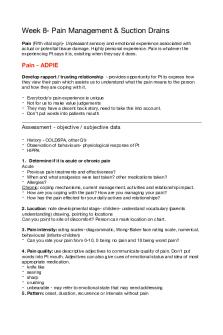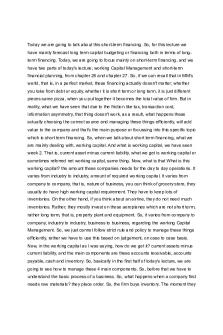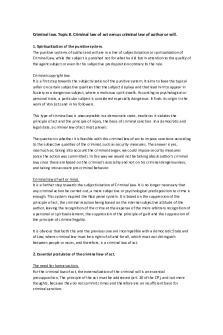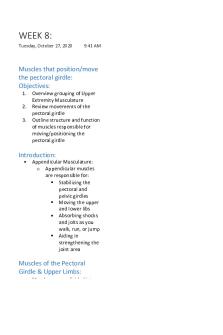Osmosis - Lecture notes 8 PDF

| Title | Osmosis - Lecture notes 8 |
|---|---|
| Course | Anatomy and Physiology I |
| Institution | California State University East Bay |
| Pages | 6 |
| File Size | 530 KB |
| File Type | |
| Total Downloads | 46 |
| Total Views | 131 |
Summary
Michael Hedrick...
Description
2/5 Osmosis ● Osmosis and Tonicity ○ Osmosis ■ Diffusion of water ■ Water moves from an area of low (solute) to an area of high (solute) ○ This is equivalent to: ■ Water moving from an area of high (H2O) to an area of low (H2O)
●
● ○ Tonicity -
■ Refers to cell’s behavior in a solution (Swelling, shrinking, not changing). Solutions can be hypotonic( call swells), hypertonic (cell shrinks), isotonic (no change)
● ○ Osmotic pressure ■ is a quantitative description of the number of particles in solution. Solutions can be hypo-osmotic, hyper-osmotic, iso-osmotic ■ Osmotic pressure = i C ● I = activity coefficient ● C = concentration ■ I M = osmolarity (osmoles/liter) ■ I = number of dissociable particles ■ (eg. sucrose = 1, NaCl = 2, CaCl2 = 3) ■ Ex. 0.2 M NaCl = 0.4 Osmolar ● (0.2 X 2 = 0.4 osmolar) ● Summary of diffusion: ○ Passive – molecules move from an area of [high] to [low] ○ Depends of Permeability and Concentration • ○ Diffusion of water (Osmosis) also occurs passively across cell membranes in response to changes in solute concentrations.
● Passive diffusion ○ uses energy from concentration gradients (i.e. from high to low
○ Requires that the molecule diffusing is permeable to the membrane (both polar and nonpolar molecules) ○ Osmosis is the diffusion of water through its own concentration gradient ● Facilitated diffusion ○ Specific for a given group of chemicals or substances (e.g. sugar specific, amino acid specific)
● ○ Passive Process (depends on concentration gradient) ○ Protein carriers are necessary because some polar solutes are too large to cross the cell membrane ○ Carriers can become saturated (limited numbers)
●
●
● Active transport ○ Requires energy (ATP) to move molecules against a concentration gradient ■ I.e. low solute to high solute ○ 1) primary active transport ■ Na - K - ATPase (sodium pump)
● ■ Pumps 3 NA out of the cell for every 2K that is pumped into the cell ■ AKA Electrogenic pump
● ○ 2) secondary active transport ■ Uses energy from ion gradients (established by primary active transport) to couple movement of ions and other molecules (eg. sugars, amino acids) against their of own concentration gradient ■ 1) co-transport (ions and molecules move in the same direction)( AKA symport)
●
●
■ 2) counter - transport (ions and molecules move in opposite directions) (AKA antiport)
●...
Similar Free PDFs

Osmosis - Lecture notes 8
- 6 Pages

8 - Lecture notes 8
- 21 Pages

8 - Lecture notes 8
- 21 Pages

8 Midwifery - Lecture notes 8
- 3 Pages

Taxation 8 - Lecture notes 8
- 2 Pages

Week 8 - Lecture notes 8
- 6 Pages

Dox 8 - Lecture notes 8
- 21 Pages

Lesson 8 - Lecture notes 8
- 2 Pages

Assignment 8 - Lecture notes 8
- 4 Pages

Week 8 - Lecture notes 8
- 23 Pages

WEEK 8 - Lecture notes 8
- 10 Pages

CL-8 - Lecture notes 8
- 12 Pages

Tema 8 - Lecture notes 8
- 8 Pages

Lesson 8 - Lecture notes 8
- 19 Pages

Chapter 8 - Lecture notes 8
- 7 Pages

Chapter 8 - Lecture notes 8
- 2 Pages
Popular Institutions
- Tinajero National High School - Annex
- Politeknik Caltex Riau
- Yokohama City University
- SGT University
- University of Al-Qadisiyah
- Divine Word College of Vigan
- Techniek College Rotterdam
- Universidade de Santiago
- Universiti Teknologi MARA Cawangan Johor Kampus Pasir Gudang
- Poltekkes Kemenkes Yogyakarta
- Baguio City National High School
- Colegio san marcos
- preparatoria uno
- Centro de Bachillerato Tecnológico Industrial y de Servicios No. 107
- Dalian Maritime University
- Quang Trung Secondary School
- Colegio Tecnológico en Informática
- Corporación Regional de Educación Superior
- Grupo CEDVA
- Dar Al Uloom University
- Centro de Estudios Preuniversitarios de la Universidad Nacional de Ingeniería
- 上智大学
- Aakash International School, Nuna Majara
- San Felipe Neri Catholic School
- Kang Chiao International School - New Taipei City
- Misamis Occidental National High School
- Institución Educativa Escuela Normal Juan Ladrilleros
- Kolehiyo ng Pantukan
- Batanes State College
- Instituto Continental
- Sekolah Menengah Kejuruan Kesehatan Kaltara (Tarakan)
- Colegio de La Inmaculada Concepcion - Cebu